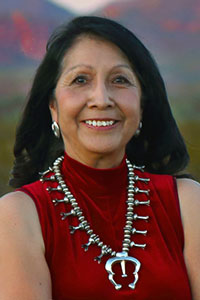Have you ever washed a rental car? Had its oil changed? Or given it a tune-up? Most people would say no, because they don’t have the desire to take care of a car that they don’t own.
Jeff Fuller, superintendent of Whiteriver Unified School District, says he often uses this analogy to explain why some kids in his district struggle in taking pride in their education. They don’t own their “car.”
Whiteriver Unified students holding signs of what they plan to do for their future careers. Photo courtesy Whiteriver Unified School District.
“We want the kids to own what their success is going to be,” he said.
Whiteriver Unified School District is located on the Fort Apache Reservation in parts of Navajo, Gila and Apache counties in Arizona and serves the White Mountain Apache Tribe. It consists of about 2,300 students across five traditional schools and one alternative high school. Violent crime, suicide, depression and high unemployment rate are issues that people of the White Mountain Apache community deal with regularly.
About five years ago, Whiteriver Unified conducted research and talked to parents and students in an attempt to raise test scores. What the district learned was that what administrators thought was important didn’t match up with what families and students thought was important.
“Is a single test really the best indicator of student success? Could it be that I am asking them to take care of a car that they don’t own?” Fuller asked. “How do you get them to have a car that they own, that they want to take care of and want to take ownership in, rather than us telling them what is important?”
Theresa Price, director of Native American Education Program for Mesa Public Schools, was named 2014 Woman of the Year by Phoenix Indian Center. Photo courtesy Mesa Public Schools
Educators should “look at tribal values and academic values and find ways to bridge those together to help students succeed,” said Theresa Price, director of Native American education programs for Mesa Public Schools and the Phoenix Indian Center’s 2014 Woman of the Year. Price is Hopi and Navajo.
“Each child has a significant background of tribal history, tribal ceremonies and tribal teachings that they come to school with,” Price said. “Students are living in two worlds – their cultural world and society. It’s a challenge sometimes to bring together these two worlds.”
The answer that Fuller and Whiteriver Unified came up with was to instill a sense of hope and optimism into the students through the Kids at Hope program. Whiteriver is the first reservation school district in the United States to adopt the Phoenix-based non-profit organization’s program that connects children with caring adults who believe in them to help them draw a road map to reach the future they want.
According to its website, Kids at Hope inspires, empowers, and transforms families, youth serving organizations (schools, parks and recreation departments, police and fire departments, etc.) and entire communities to create an environment where all children experience success, no exceptions!
“It is not so much a program as it is a philosophy,” Fuller said. “If you have hope for your future, all of a sudden there are things that you are doing towards that hope that become relevant to you and school can be a part of that.”
Superintendent Jeff Fuller helped to establish the Kids at Hope Program at Whiteriver Unified School District. The program works to create an environment where all children experience success. Photo courtesy of Whiteriver Unified School District.
Through Kids at Hope, Whiteriver Unified focuses on four destinations for student success: home and family, education and career, community service and hobbies and recreation. Students believe in themselves, connect with caring adults, set goals, “time-travel” to what their future will be, and learn how school is a path that can get them there, Fuller said.
Every morning after the pledge of allegiance, Fuller said students at Whiteriver recite the following pledge: “I am a kid at hope. I am smart, talented and capable of success. I have hopes and dreams for the future,chin and I will climb hard to reach those dreams every day. All kids are capable of success. No exceptions!”
Fuller said he knows that standardized testing is important, but he would rather have children reflect back on their lives and define their success based on a broader range of factors such as their job, family and life look, not what score they received on a test.
“We want the kids to own what their success is going to be,” he said.
The support of a caring adult at school helped ultra-runner and Navajo Nation member Shaun Martin see the value of education after being “that kid at school that no one wanted to have in their classroom.”
“Coach Mark Lomeland, the cross country coach at the high school who coached my older brothers, saw the potential in me and moved down to the middle school just to coach me,” said Martin, now athletic director for Chinle Unified School District and the 2012 National Rural School Teacher of the Year. “Then he saw my grades, and he said ‘Shaun, if you don’t have all A’s by the time of that first grade check for the first meet then you’re not going.’ I had straight A’s until I graduated.”
Shaun Martin, behind computer, with his students who are higlighting their progression. Photo courtesy Chinle Unified School District.
Martin shared his story on April 10 at The Equity Event. Fuller and Price also presented at the event, a first-of-its-kind undertaking, which was hosted by Arizona School Boards Association in partnership with the Helios Education Foundation and WestEd and with support from the national Minority Student Achievement Network.
After finishing college, Martin said he returned to the reservation to share with students the same care and guidance he received from Lomeland and infused the Navajo culture into his lessons, workouts and relationship building. His students have won 12 state titles and 19 individual state championships, but Martin said, “the biggest number, I hang my hat on is we sent 49 kids to college on scholarships.”
Besides the Kids at Hope program, Whiteriver Unified also works to create student success by engaging students and parents through STEM/STEAM programs.
Through federal school improvement grants for technology, Whiteriver has been able to bring science, technology, engineering and math programs into its schools.
“We started doing project-based learning modules where the kids worked in teams to come up with solutions to real problems that have to do with them,” Fuller said.
Whiteriver Unified robotics students from Alchesay High School compete in a robotics competition at Grand Canyon University in early April. Photo courtesy Whiteriver Unified School District.
Through these projects, students are being given the tools to prepare for future jobs in their communities. Instead of hiring help outside of the reservation to engineer and sustain projects, Fuller said the schools are preparing their students to fill these positions.
“Multi-million dollar companies are now in our tribal communities,” Price said. “We need to educate every person in our community for these opportunities.”
One example Fuller gave was high school students’ collaboration to construct a working model of a pipeline for the dam along the White River using high-level math.
“These are kids that are struggling with Algebra II and they are doing calculus,” Fuller said. “Why is that? Because it meant something to them. They are starting to own their car.”
Another program Whiteriver Unified has implemented to get students excited about learning is a robotics and STEM camp.
A Whiteriver Unified student from Alchesay High School works on the team’s robot. Photo courtesy Whiteriver Unified School District.
For the last four years instead of placing students in summer school for remedial math class, Whiteriver has opted to offer Discovery Learning camp or STEM camp to elementary students. Starting this summer, Whiteriver will offer this program to high school students as well, Fuller said.
“The kids are getting the math because they are doing really fun projects that are STEM oriented,” Fuller said.
A video of the Discovery Learning camp showed students excited about alternate learning and their STEM projects and accomplishments. At the end of the camp, parents were invited to visit the classrooms to learn about the projects their children created.
“Every day we hear our kids come home and tell us stories of what they did,” one parent in the video said. “To actually come here and see all the hard work they put in is great.”
Fuller also explained that elementary school students are being immersed into programs where they get to interact with professionals that have jobs that they aspire for in zoology, botany, hydrology and ecology, for example.
“These kids are starting to see and interact with people that do these kinds of things,” Fuller said. “They are starting to see that these are jobs that are going to be in my community when I grow up. So these are things they are starting to get excited about.”
In order to successfully implement and sustain their programs, Whiteriver has received grants to hire licensed counselors and social workers, and STEM and technology integration coaches at each school site.
Whiteriver Unified students working on class projects in the garden on campus. Photo courtesy Whiteriver Unified School District.
Whiteriver Unified is currently working on executing a strategic technology plan for the next three years in order to properly fund and prioritize all of their STEM programs.
Ultimately, student success is more than just a test score; it is about educating the whole child, Fuller said. Looking at youth development in the 21st Century, he emphasized that students aren’t at risk but “at hope.”
“They have got to own their future,” Fuller said. They have to time travel to that future and come back and start working towards what that future is. I believe that the rest, as far as test scores and everything else, is going to get there and it will follow once the kids own their car.”












